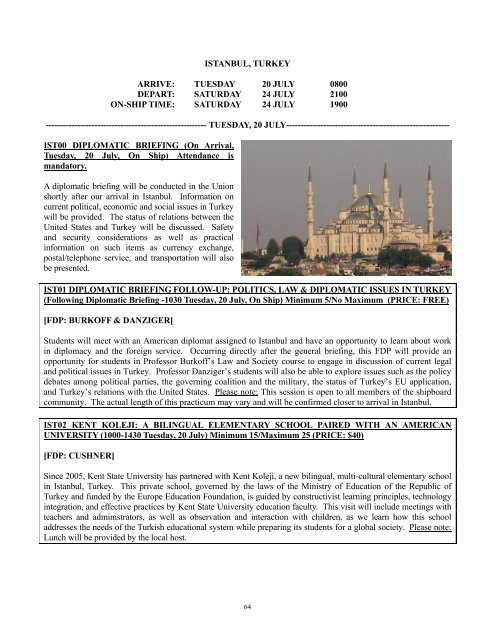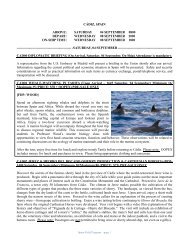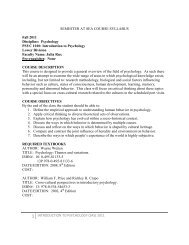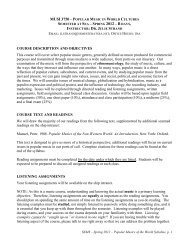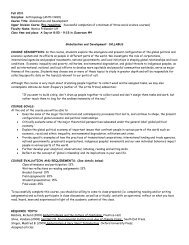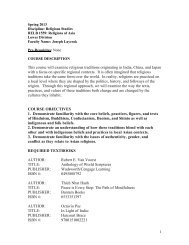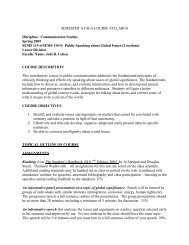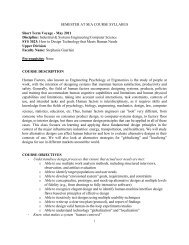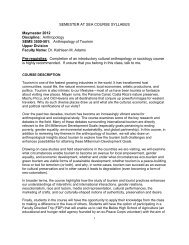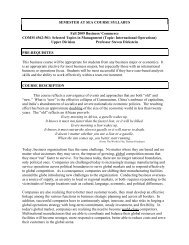istanbul, turkey arrive: tuesday 20 july 0800 depart - University of ...
istanbul, turkey arrive: tuesday 20 july 0800 depart - University of ...
istanbul, turkey arrive: tuesday 20 july 0800 depart - University of ...
Create successful ePaper yourself
Turn your PDF publications into a flip-book with our unique Google optimized e-Paper software.
ISTANBUL, TURKEY<br />
ARRIVE: TUESDAY <strong>20</strong> JULY <strong>0800</strong><br />
DEPART: SATURDAY 24 JULY 2100<br />
ON-SHIP TIME: SATURDAY 24 JULY 1900<br />
-------------------------------------------------------- TUESDAY, <strong>20</strong> JULY---------------------------------------------------------<br />
IST00 DIPLOMATIC BRIEFING (On Arrival,<br />
Tuesday, <strong>20</strong> July, On Ship) Attendance is<br />
mandatory.<br />
A diplomatic briefing will be conducted in the Union<br />
shortly after our arrival in Istanbul. Information on<br />
current political, economic and social issues in Turkey<br />
will be provided. The status <strong>of</strong> relations between the<br />
United States and Turkey will be discussed. Safety<br />
and security considerations as well as practical<br />
information on such items as currency exchange,<br />
postal/telephone service, and transportation will also<br />
be presented.<br />
IST01 DIPLOMATIC BRIEFING FOLLOW-UP: POLITICS, LAW & DIPLOMATIC ISSUES IN TURKEY<br />
(Following Diplomatic Briefing -1030 Tuesday, <strong>20</strong> July, On Ship) Minimum 5/No Maximum (PRICE: FREE)<br />
[FDP: BURKOFF & DANZIGER]<br />
Students will meet with an American diplomat assigned to Istanbul and have an opportunity to learn about work<br />
in diplomacy and the foreign service. Occurring directly after the general briefing, this FDP will provide an<br />
opportunity for students in Pr<strong>of</strong>essor Burk<strong>of</strong>f’s Law and Society course to engage in discussion <strong>of</strong> current legal<br />
and political issues in Turkey. Pr<strong>of</strong>essor Danziger’s students will also be able to explore issues such as the policy<br />
debates among political parties, the governing coalition and the military, the status <strong>of</strong> Turkey’s EU application,<br />
and Turkey’s relations with the United States. Please note: This session is open to all members <strong>of</strong> the shipboard<br />
community. The actual length <strong>of</strong> this practicum may vary and will be confirmed closer to arrival in Istanbul.<br />
IST02 KENT KOLEJI: A BILINGUAL ELEMENTARY SCHOOL PAIRED WITH AN AMERICAN<br />
UNIVERSITY (1000-1430 Tuesday, <strong>20</strong> July) Minimum 15/Maximum 25 (PRICE: $40)<br />
[FDP: CUSHNER]<br />
Since <strong>20</strong>05, Kent State <strong>University</strong> has partnered with Kent Koleji, a new bilingual, multi-cultural elementary school<br />
in Istanbul, Turkey. This private school, governed by the laws <strong>of</strong> the Ministry <strong>of</strong> Education <strong>of</strong> the Republic <strong>of</strong><br />
Turkey and funded by the Europe Education Foundation, is guided by constructivist learning principles, technology<br />
integration, and effective practices by Kent State <strong>University</strong> education faculty. This visit will include meetings with<br />
teachers and administrators, as well as observation and interaction with children, as we learn how this school<br />
addresses the needs <strong>of</strong> the Turkish educational system while preparing its students for a global society. Please note:<br />
Lunch will be provided by the local host.<br />
64
IST03 BYZANTINE ARCHITECTURE IN ISTANBUL (1000-1800 Tuesday, <strong>20</strong> July) Minimum <strong>20</strong>/<br />
Maximum 30 (PRICE: $79)<br />
[FDP: SILVER]<br />
This tour will focus on the historic city center—both <strong>of</strong> Constantinople, the capital <strong>of</strong> the Byzantine Empire, led<br />
by Constantine I, as well as Istanbul, renamed by the Ottoman sultans who conquered the city in 1453. Its<br />
attention to Orthodox churches as well as mosques and baths make it an ideal introduction for Pr<strong>of</strong>essor Silver’s<br />
students to the layered and textured history <strong>of</strong> this eternal capital.<br />
Drive over the Golden Horn into the Old Town where<br />
you will visit the Kariye Museum, formerly the Chora<br />
Church or “Church <strong>of</strong> the Holy Savior Outside the<br />
Walls.” Constantine I built this monastery/church<br />
outside the city walls during the fourth century. It later<br />
served as a mosque (Kariye Camii) and is now a<br />
museum. The current building was built in the late 11 th<br />
century, with numerous repairs and restructuring in the<br />
following centuries. Most <strong>of</strong> the interior decorations, the<br />
famous mosaics, and the mural paintings date from<br />
about 13<strong>20</strong>.<br />
Continue driving along the restored city walls to the Golden Horn Gate and Seven Towers where Roman armies<br />
entered the city. Visit the Church <strong>of</strong> Sergius and Bacchus (Kucuk Ayas<strong>of</strong>ya Cami), the palace chapel <strong>of</strong> Justinian,<br />
and the Mosaic Museum. Tour the underground sixth-century Basilican cistern with its brickwork vaulting<br />
supported by 336 Corinthian columns. Walk to the Hippodrome to view the Obelisk <strong>of</strong> Theodosius and the bronze<br />
Serpentine Column. The last stop is Hagia Sophia (Ayas<strong>of</strong>ya Museum), a fifth-century basilica with an immense<br />
dome, which is the largest in Istanbul and still considered to be an architectural marvel. Please note: This trip is<br />
recommended for all Art History students and involves a considerable amount <strong>of</strong> walking. Box lunches from the<br />
ship will be provided.<br />
IST04 ADVERTISING IN TURKEY (1100-1400 Tuesday, <strong>20</strong> July) Minimum 12/Maximum <strong>20</strong> (PRICE: $28 +<br />
OOPEX) PRE-SALE ONLY<br />
[FDP: BIPPUS]<br />
Advertising is one <strong>of</strong> the most prevalent and accessible social artifacts that we encounter on our journeys. Özlem<br />
Sandikci is an assistant pr<strong>of</strong>essor <strong>of</strong> marketing at Bilkent <strong>University</strong> in Ankara, Turkey, and an expert on the<br />
religious and cultural significance <strong>of</strong> clothing as it intersects with modern living, the politics <strong>of</strong> representation in<br />
advertising, and the social implications <strong>of</strong> consumerism in Turkey.<br />
Dr. Sandikci will meet us at the ship, give an introductory talk on these topics, then lead us on a walk through the<br />
city. We will take the Tünel and underground funicular to the Beyoğlu district and along the 3.5 kilometer-long<br />
Istiklal Street. Istiklal is a famous and historic pedestrian street—the home <strong>of</strong> numerous museums, shops, movie<br />
theatres, music venues and restaurants. Dr. Sandicki will point out sights <strong>of</strong> interest and answer questions. At the<br />
conclusion <strong>of</strong> the tour, students will be free to explore the city and return to the ship on their own. Please note: Out<strong>of</strong>-pocket<br />
expenses includes public transportation and lunch (on your own, at the conclusion <strong>of</strong> the FDP).<br />
65
IST05 LIVABLE CITIES: THE PRINCES’ ISLANDS (1100-1500 Tuesday, <strong>20</strong> July) Minimum 10/Maximum<br />
30 (PRICE: $8 + OOPEX)<br />
[FDP: MANIATES]<br />
This practicum will explore the creative approaches to livable cities including car-free zones and efficient modes<br />
<strong>of</strong> transportation. We will enjoy an on-ship presentation by Dr. Kevser Ustundag, who specializes in urban<br />
planning, on the topic <strong>of</strong> “Sustainability in Istanbul.” We will continue the discussion over lunch on the ship and<br />
then take the ferry to the Princes’ Islands, which is a unique car-free zone in Istanbul. Participants will be given a<br />
field-based assignment related to the topic <strong>of</strong> sustainability while visiting the islands.<br />
The name <strong>of</strong> Princes’ Islands comes from the Byzantine period when royal princes and empresses were exiled<br />
there. With the introduction <strong>of</strong> steamboats during the late Ottoman period around the 19 th century, these islands<br />
became popular resorts for the wealthy who built wooden houses there. Jewish, Greek and Armenian<br />
communities made up a large number <strong>of</strong> the inhabitants here. There are many monasteries and historic buildings<br />
on the islands, besides 19th-century Victorian-style wooden mansions. Motorists (except the ones belonging to<br />
the local municipality for public works) are not permitted on the islands; therefore, you must walk or rent a<br />
bicycle, a fayton (horse-drawn carriage) or even a donkey. Please note: At the conclusion <strong>of</strong> the FDP, participants<br />
will have the option <strong>of</strong> returning to the ship with Pr<strong>of</strong>essor Maniates or taking a later ferry on their own. Out-<strong>of</strong>pocket<br />
expenses include money for any optional purchase on the islands.<br />
IST06 ISTANBUL CITY ORIENTATION (1100-1700 Tuesday, <strong>20</strong> July) Minimum 35/No Maximum (PRICE:<br />
$52)<br />
[FDP: MacMILLAN]<br />
Byzantium, Constantinople and Istanbul are names that conjure up images <strong>of</strong> a great city’s past: Byzantium, the city<br />
founded by Mergarian colonizers 2,600 years ago; Constantinople, built on seven hills by the Emperor Constantine;<br />
and Istanbul, the city that links Europe and Asia and the fabulous capital <strong>of</strong> the Ottoman sultans. Istanbul is not only<br />
a city with a colorful past, but also a bustling modern-day city full <strong>of</strong> life and activity. During this orientation to the<br />
city, view some <strong>of</strong> the most significant historical and cultural sites in Istanbul.<br />
Drive through the streets <strong>of</strong> ancient Pera (Latin Quarter) and Taksim Square. Then cross the Golden Horn over the<br />
Ataturk Bridge to the old town. View the city walls dating back to the fourth century, which were destroyed during<br />
the conquest in 1453, and the Roman Aqueduct <strong>of</strong> Valens from the second century. Tour the Sehzade Mosque,<br />
which was designed by architect Mimar Sinan. As chief<br />
architect <strong>of</strong> the palace, Sinan designed more than 360<br />
structures. The Sehzade Mosque represents his mature<br />
style and the first grand mosque he created. Drive by the<br />
Hippodrome and view the Serpentine Column and the<br />
Theodosius Column, both <strong>of</strong> which were brought from<br />
Egypt in the fourth century. Next, visit the Blue Mosque<br />
with its unique configuration <strong>of</strong> six minarets and bluetiled<br />
interior. Conclude your orientation with a visit to<br />
Hagia Sophia and the Byzantine Cistern. Please note:<br />
This trip involves a fair amount <strong>of</strong> walking. Bring water.<br />
Box lunches from the ship will be provided. Visitors to<br />
the mosque must cover their arms and head to enter.<br />
66
IST07 KADIR HAS UNIVERSITY: CONVERSATION WITH THEATRE COUNTERPARTS (1230-1600<br />
Tuesday, <strong>20</strong> July) Minimum 10/Maximum <strong>20</strong> (PRICE: $26)<br />
[FDP: C. GILLESPIE]<br />
Our visit with theatre faculty and students at Kadir Has <strong>University</strong> provides us with the opportunity to share<br />
perspectives with our Turkish counterparts on topics <strong>of</strong> mutual interest, including performance practices and<br />
training, scenography, public/private support for the arts, drama in school curricula, and other topics in an informal,<br />
conversational setting.<br />
IST08 MODERN CULTURE IN ISTANBUL: ISTIKLAL STREET (1230-1630 Tuesday, <strong>20</strong> July) Minimum<br />
15/Maximum 25 (PRICE: $21 + OOPEX)<br />
[FDP: FAIRLEY]<br />
For a dose <strong>of</strong> modern pop culture Istanbul style, head to its most famous pedestrian avenue: Istiklal Street. Begin<br />
your tour at the city’s most popular square: Taksim Square. Between Taksim and Tünel (site <strong>of</strong> the world’s secondoldest<br />
subway station), observe a vast array <strong>of</strong> boutiques, bookstores, cafes, clubs and galleries—and the thousands<br />
<strong>of</strong> people who throng the area at virtually any time <strong>of</strong> day. Pr<strong>of</strong>essor Fairley’s students should pay particular<br />
attention to Turkey’s youth fashion in order to gauge the influence <strong>of</strong> American hip-hop culture. In addition to<br />
observing youth fashion, students must be aware <strong>of</strong> the types <strong>of</strong> businesses that sell music, fashion, jewelry<br />
associated with hip-hop culture. Describe two shops and the goods being sold. How are these items displayed?<br />
Describe the customers in these shops. How are Turkish youth similar to or different from American hip-hoppers?<br />
What aspects <strong>of</strong> local hip-hop culture appear to be unique to Istanbul? Please note: Tram fare is included in the trip<br />
price. Participants who opt to remain in the city and make their own way back to the ship will need currency for the<br />
return trip. Out-<strong>of</strong>-pocket expenses include any optional purchases you might make after the FDP has ended.<br />
IST09 KAPALI KARSI, THE GRAND BAZAAR (1230-1630 Tuesday, <strong>20</strong> July) Minimum 15/Maximum <strong>20</strong><br />
(PRICE: $21 + OOPEX)<br />
[FDP: DANESHYAR]<br />
Participants in Pr<strong>of</strong>essor Daneshyar’s FDP will explore<br />
Kapali Karsi, Istanbul’s Grand Bazaar. A small city in itself,<br />
Kapali Karsi contains some 4,000 shops and ateliers selling<br />
everything from oriental rugs to costume jewelry. The<br />
cavernous bazaar is divided into various sectors, each with<br />
dozens <strong>of</strong> shops selling one particular good. Linger in the<br />
jewelry sector and admire the intricate designs <strong>of</strong> silver<br />
jewelry. Visit the carpet shops and appreciate the beautiful<br />
patterns and colors <strong>of</strong> carpets woven by local artisans. The<br />
interaction with the merchants provides a glimpse into the<br />
local culture as you observe the trade in handicrafts produced<br />
by Turkish craftsmen. The bargaining is all very polite. It is<br />
really a game, and it should be played according to the time-honored rules. If you <strong>of</strong>fer a price and the merchant<br />
accepts it, you have to buy the good. Don’t be in a hurry. Notice how the merchants can negotiate with a<br />
rudimentary knowledge <strong>of</strong> English. If the trader <strong>of</strong>fers you a cup <strong>of</strong> (delicious) mint tea, do accept the <strong>of</strong>fer as a sign<br />
<strong>of</strong> respect. Please note: Out-<strong>of</strong>-pocket expenses include any optional purchases you might make at the bazaar.<br />
Enjoy the sights and sounds <strong>of</strong> this impressive market and Pr<strong>of</strong>essor Daneshyar’s perfected art <strong>of</strong> bargaining!<br />
67
IST10 NEW MOSQUE/SPICE BAZAAR/SÜLEYMANIYE MOSQUE (1230-1630 Tuesday, <strong>20</strong> July)<br />
Minimum 15/Maximum 25 (PRICE: $26)<br />
[FDP: BOESCHENSTEIN]<br />
After walking across the Golden Horn on Galata Bridge,<br />
participants in Pr<strong>of</strong>essor Boeschenstein’s architectural walking<br />
tour will view the New Mosque (1597), visit the Spice Bazaar<br />
(founded in the early 17 th century) and continue on to the<br />
Süleymaniye Mosque, one <strong>of</strong> the city’s largest mosques and one<br />
illustrative <strong>of</strong> Byzantine urban development. With a magnificent<br />
domed prayer space and extensive ancillary facilities—including a<br />
hospital, schools, library, kitchens, bathhouses, hostel and gardens,<br />
as well as the tomb <strong>of</strong> the justifiably proud architect Sinan—the<br />
mosque complex was Istanbul’s major urban initiative <strong>of</strong> its time<br />
(mid-16 th century) and served as the religious and social center for<br />
its district. Although skyscrapers are reshaping Istanbul’s historic<br />
image, this mosque remains an indelible mark on, and dramatic<br />
feature <strong>of</strong>, today’s skyline.<br />
IST11 MAGIC IN ISTANBUL (1300-1700 Tuesday, <strong>20</strong> July) Minimum 12/Maximum 21 (PRICE: TBA)<br />
[FDP: SETTON]<br />
With local magician Lee Alex as our host, participants in this FDP will visit two “magical” sites in the magical city<br />
<strong>of</strong> Istanbul: the legendary Maiden’s Tower (reachable by ferry) and the mystical Yerebatan Cistern. Our magicianguide<br />
will enlighten us about the history and legends related to each site. Afterward, we will return to the ship where<br />
Mr. Alex will conduct a workshop in the art <strong>of</strong> magic and magical thinking. This experience will provide insights<br />
for students in Pr<strong>of</strong>essor Setton’s courses into the ways in which ancient and modern magic coexist and inform each<br />
other. The FDP will be particularly relevant to the students <strong>of</strong> the Myth, Magic and Mystery course, who will have<br />
been studying myths and magic in the Mediterranean world; it will <strong>of</strong>fer suggestions on how to create their own<br />
magic.<br />
IST12 WOMEN AND THE LAW IN TURKEY (1330-1730 Tuesday, <strong>20</strong> July) Minimum 15/Maximum 45<br />
(PRICE: $18)<br />
[FDP: BURKOFF & KANTROWITZ]<br />
We will learn about women and the law in Turkey from those who know it best: practicing attorneys and judges.<br />
The Istanbul Bar Association is the largest bar association in Turkey, with membership in excess <strong>of</strong> <strong>20</strong>,000. The Bar<br />
Association’s Women’s Rights Centre provides advocacy and legal services to women in need. Participants will visit<br />
the association’s headquarters and meet with the president and other leaders <strong>of</strong> the Women’s Rights Centre, along<br />
with a family court judge, who will speak and answer our questions on legal issues affecting women and their<br />
families.<br />
As Pr<strong>of</strong>essor Burk<strong>of</strong>f’s students <strong>of</strong> Law and Society will learn, women’s legal issues are family issues. This is an<br />
excellent opportunity to learn about the Turkish legal system, particularly as it affects women’s lives, to learn from<br />
lawyers and judges what issues they consider significant, and to ask questions based upon the discussions we have<br />
had in class on such issues as honor killings, domestic violence and women’s rights.<br />
68
---------------------------------------------------- WEDNESDAY, 21 JULY ----------------------------------------------------<br />
IST13 SOUTHERN TURKEY: ANTALYA (0615 Wednesday, 21 July – 2100 Thursday, 22 July) Minimum<br />
21/Maximum 40 (PRICE: $669) PRE-SALE ONLY<br />
The hub <strong>of</strong> Turkey’s 700-mile-long Mediterranean coast is Antalya, a small city <strong>of</strong> some 150,000. Its natural<br />
assets include a strategic location at the heart <strong>of</strong> a fertile agricultural region, a natural harbor, unpolluted air, a<br />
wonderful climate and attractive beaches. This practicum should be especially attractive to those interested in<br />
ancient history and archaeological sites.<br />
Founded early in the second century BCE by Attalus II <strong>of</strong> Pergamon, and consequently named Attaleia, the city<br />
passed into Roman hands soon afterward. It later became a Byzantine city and remained one until 1<strong>20</strong>7 when it was<br />
taken by the Seljuks, who altered its name to Antalya. It fell to the Ottomans in 1391.<br />
ITINERARY:<br />
Day 1: Transfer to the Istanbul airport, with box breakfast from the ship, for your flight to Antalya. Upon arrival,<br />
visit the Archaeological Museum <strong>of</strong> Antalya, one <strong>of</strong> the finest collections in Turkey. The exhibits are user-friendly,<br />
handsomely arranged and clearly labeled in English. Exhibits represent all periods in the country’s history—<br />
including the Greek, Roman, Byzantine, Seljuk and Ottoman eras. Then drive northward to the Taurus Mountains to<br />
visit the ancient city <strong>of</strong> Termessos that lies atop the mountain in the midst <strong>of</strong> a national park. See the city walls,<br />
agora, theater, the Roman gateway, and the necropolis with its giant sarcophagi and burial chambers. Return to<br />
Antalya for dinner and overnight. (Box B, D; Antalya area hotel)<br />
Day 2: Discover the ancient region <strong>of</strong> Pamphylia, which lies to the east. According to ancient Greek sources,<br />
Pamphylia was settled by a “mixed multitude” <strong>of</strong> peoples after the fall <strong>of</strong> Troy in 1184 BCE. First visit the ancient<br />
city <strong>of</strong> Perge founded around 1000 BCE. It was an important trading city, and it is believed that St. Paul visited<br />
Perge on his first missionary journey. See the stadium that dates back to the second century. Walk through the<br />
colonnaded street and view the acropolis, and the agora that features shops paved with colorful floor mosaics.<br />
Continue to the ancient city <strong>of</strong> Side, once a trysting place <strong>of</strong> Antony and Cleopatra, to view the Greek-style<br />
amphitheater built on arches, the Temple <strong>of</strong> Apollo, and the agora. The extensive Roman bath, now a museum,<br />
houses the relics found in the excavations. In the afternoon, drive to ruins <strong>of</strong> Aspendos on the banks <strong>of</strong> the river to<br />
view the aqueducts <strong>of</strong> Roman times and the spectacular Roman theater that held 15,000 spectators. Transfer to the<br />
Antalya airport for your return flight to Istanbul. (B, Snack on plane)<br />
IST14 WESTERN TURKEY: IONIAN CIVILIZATIONS (0630 Wednesday, 21 July – <strong>20</strong>30 Thursday, 22<br />
July) Minimum 21/No Maximum (PRICE: $687) PRE-SALE ONLY<br />
Izmir was founded in the first half <strong>of</strong> the third millennium BCE and at present is the third largest city in Turkey<br />
and the second largest port (after Istanbul). The ancient ruins in the city’s first settlement <strong>of</strong> Bayrakli are a<br />
reminder <strong>of</strong> the city’s rich past. Nearby is the city <strong>of</strong> Ephesus, unmatched by any archaeological site in the world<br />
in terms <strong>of</strong> sheer magnitude. Ruins include cities dating from the Hellenistic, Roman and Byzantine eras, adorned<br />
with splendid monuments, theaters, temples, agoras, gymnasia and libraries. A visit to Sardis, which was as<br />
important as the city <strong>of</strong> Croesus was to the Lydian Empire, is included. The most spectacular structure <strong>of</strong> the<br />
Sardis excavations is the Artemis Temple. Please note: Wear sturdy shoes and bring a sun hat, sunscreen,<br />
swimsuit and water bottle.<br />
ITINERARY:<br />
Day 1: Transfer to Istanbul Airport for the one-hour flight to Izmir. Upon arrival, drive to the city <strong>of</strong> old Smyrna<br />
and visit the agora <strong>of</strong> ancient Smyrna and the Archaeological Museum <strong>of</strong> Izmir, which holds the relics found at the<br />
excavation <strong>of</strong> Ionian and Eolian cities. Next, drive one hour eastward to Sardis to visit the Artemis Temple, the<br />
earliest synagogue excavation sites, and the Royal Persian Road that reached to Sousa, Persia. Continue to Selcuk<br />
for dinner and overnight. (Box B, D; Selcuk area hotel)<br />
Day 2: After breakfast discover Ephesus. See what little remains <strong>of</strong> the Temple <strong>of</strong> Artemis (Diana’s Temple), one<br />
69
<strong>of</strong> the Seven Wonders <strong>of</strong> the Ancient World. Visit the Archaeological Museum <strong>of</strong> Ephesus and the Basilica <strong>of</strong> St.<br />
John. In the afternoon, visit the ancient city <strong>of</strong> Ephesus. See the agora, town hall, Roman baths, fountains, Celcus<br />
Library and the Grand Theater. In the late afternoon transfer to the Izmir Airport for your return flight to Istanbul.<br />
(B, Snack on plane)<br />
IST15 CAPPADOCIA (0630 Wednesday, 21 July - 2230 Thursday, 22 July) Minimum 31/Maximum 80<br />
(PRICE: $697) PRE-SALE ONLY<br />
Imagine a region transformed from a blazing inferno into a<br />
flourishing village. Cappadocia, or “Land <strong>of</strong> Well-Bred Horses,”<br />
began with the eruption <strong>of</strong> two volcanoes, Erciyes Dagi and<br />
Melendiz Dagi. When hot ash was dispersed over the terrain, it<br />
created a thick layer <strong>of</strong> s<strong>of</strong>t, porous stone called tuff. The wealthy<br />
believed it to be barren land, but the poor saw a means <strong>of</strong> survival<br />
and a miracle <strong>of</strong> nature. The indigenous people used crude tools to<br />
carve sturdy homes out <strong>of</strong> this pliable substance. Eventually they<br />
carved churches, schools and an entire village. To escape<br />
persecution, the Christians also built underground cities.<br />
The geological landscape <strong>of</strong> Cappadocia is quite unusual—obelisks<br />
and cone shapes that jut out <strong>of</strong> the terrain. Erosion wore away<br />
sections <strong>of</strong> tuff and created these “fairy chimneys” (conical rock<br />
formations). The chimneys usually have basalt—a hard, dense,<br />
dark volcanic rock—at the very top. Although the land is rugged and dry, it is remarkably fertile. Nevsehir, the<br />
wealthy center <strong>of</strong> Cappadocia, is the provincial capital and largest town in the region. The landscape <strong>of</strong> Nevsehir<br />
resembles the surface <strong>of</strong> the moon. You will visit the rock-carved, cave-like churches. In the old city <strong>of</strong> Avanos you<br />
can see calcium pools and thermal springs. Ortahisar, another nearby village, has a rock that dominates the town.<br />
This 86-meter wonder once housed the whole village. Also visit the underground cities <strong>of</strong> Kaymakliı, which<br />
descend nine floors below ground level. Please note: Be sure to wear walking shoes and bring a flashlight.<br />
ITINERARY:<br />
Day 1: Transfer to Istanbul airport for your flight to Kayseri. Upon arrival, transfer to the Cappadocia region. Visit<br />
the town <strong>of</strong> Urgup before proceeding in the afternoon to the underground city <strong>of</strong> Kaymakliı, where Christians hid<br />
during times <strong>of</strong> persecution. Explore the “extra-terrestrial” landscape <strong>of</strong> Nevsehir. View the valley from Uchisar<br />
natural citadel. In the evening enjoy a performance <strong>of</strong> Whirling Dervishes. Dinner and overnight in Cappadocia.<br />
(Box B, D; area hotel)<br />
Day 2: After breakfast visit the rock-carved churches, monasteries and homes in the valleys <strong>of</strong> Goreme Valley and<br />
the settlements at Zelve Valley; see the “fairy chimneys” at Pasabag. Visit the town <strong>of</strong> Avanos, and the villages <strong>of</strong><br />
Ortahisar and Sinassos. Enjoy these rock-hewn areas and explore<br />
them at your leisure. In the late afternoon, transfer to Kayseri<br />
airport for the return flight to Istanbul. (B, L)<br />
IST16 OPTIONAL HOT AIR BALLOON RIDE (Scheduled<br />
during Cappadocia trip, Thursday 22 July) No<br />
Minimum/Maximum <strong>20</strong> (PRICE: $250) PRE-SALE ONLY<br />
NOTE: You must be a participant on the above Cappadocia trip<br />
in order to register for this option. Weather permitting, your<br />
balloon ride is scheduled to take place the morning <strong>of</strong> Day 2.<br />
70
IST17 PRINCES’ ISLES (0830-1330 Wednesday, 21 July) Minimum 26/No Maximum (PRICE: $43)<br />
Walk to the Kabatas Pier for a ferry ride to Buyukada, the largest and the most famous among five other Princes’<br />
Islands. En route, view the scenery <strong>of</strong> the Asian side and the islands at Marmara Sea. Upon arrival at Buyukada,<br />
take a faiton (horse-driven coach) ride around the island, view the elaborately decorated wooden houses and villas.<br />
Enjoy a short break for tea before continuing your ride along the water and back to the pier. Walk through the<br />
downtown area and enjoy some free time before taking the ferry back to Istanbul.<br />
IST18 GALLIPOLI/CANAKKALE/TROY (0830 Wednesday, 21 July – 1800 Thursday, 22 July) Minimum<br />
31/No Maximum (PRICE: $167) PRE-SALE ONLY<br />
The slender Gelibolu (Gallipoli) Peninsula is endowed with some fine scenery and beaches but burdened with a grim<br />
military history. The World War I battlefields and Allied cemeteries scattered along the peninsula are both moving<br />
and numbing with the sheer number <strong>of</strong> graves, memorials and obelisks. The Gallipoli campaign lasted for nine<br />
months in 1915-1916 and resulted in huge numbers <strong>of</strong> casualties on both the Turkish and Allied sides.<br />
Thanks to Homer, Troy is probably the most celebrated archaeological site in Turkey. However, it is not the most<br />
spectacular. Until the late 1800s, it was generally thought that Troy (Truva) existed in legend only. In 1886, an<br />
amateur archaeologist and German businessman, Heinrich Schliemann, obtained permission from the Ottoman<br />
government to start digging on a hill where earlier excavators had already found the remains <strong>of</strong> a classical temple.<br />
Schliemann’s work actually caused a certain amount <strong>of</strong> damage to the site, but the excavations did uncover nine<br />
layers <strong>of</strong> remains, representing distinct and consecutive city developments spanning four millennia. The oldest, Troy<br />
I, dates back to about 3600 BCE. Please note: Be sure to bring your swimsuit and a beach towel.<br />
ITINERARY:<br />
Day 1: Depart Istanbul in the morning and drive along the Sea <strong>of</strong><br />
Marmara coast past over Tekirdag and Kesan to Gallipoli. In the<br />
afternoon visit Gelibolu town and 1915 World War I Gallipoli<br />
battlefields and memorials. Later enjoy swimming in the Aegean Sea.<br />
Continue to Eceaabat by ferry into Asia. Dinner and overnight in<br />
Canakkale. (Driving time today is about five hours.) (Box L, D; area<br />
hotel)<br />
Day 2: After breakfast visit the Canakkale Archaeological Museum<br />
and view relics that were discovered during excavations. Continue to<br />
Troy where excavations have revealed nine ancient cities. View the<br />
remains and other ruins from the various periods as well as a huge<br />
replica <strong>of</strong> the wooden Trojan horse. Return to Canakkale and board a<br />
ferry to continue the journey back to Istanbul. (B, L)<br />
IST19 BALLIKAYA HIKE – GROUP A (0900-1500 Wednesday, 21<br />
July) Minimum 30/Maximum 40 (PRICE: $43)<br />
While Istanbul is intriguing, a jaunt into the countryside provides yet another perspective on Turkey. This scenic<br />
hike through Ballikaya in Asia is considered the practice area for Turkish mountaineers. It is a plateau area deeply<br />
cut by a stream that has produced deep canyons and waterfalls. The entire area is covered by forests, orchards and<br />
vineyards. The group will be led by an experienced mountain climber. Please note: This is a strenuous hike. Wear<br />
good walking shoes and be certain to bring hats, sunscreen and plenty <strong>of</strong> water. Box lunches from the ship will be<br />
provided.<br />
71
IST<strong>20</strong> PALACES OF ISTANBUL AND ASIATIC SIDE (0900-1700 Wednesday, 21 July) Minimum 26/No<br />
Maximum (PRICE: $88)<br />
Istanbul, the only city in the world built on two continents, holds the precious relics <strong>of</strong> three empires and capitals and<br />
is a unique link between East and West, past and present. Each empire that occupied Anatolia left its indelible<br />
imprint on Turkish art and architecture.<br />
During this practicum, you will visit several palaces. The Dolmabahçe Palace, which was the second residence <strong>of</strong> the<br />
sultans until 1923, has elaborately decorated halls and rooms. The Yildiz Palace, with its Imperial Gardens, houses<br />
the Sale Pavilion, which was a guesthouse for foreign dignitaries. Next see the Aynali Kavak Palace on the Golden<br />
Horn, which is one <strong>of</strong> the oldest Ottoman Palaces in Istanbul. Continue over the Conqueror’s Bridge to the Asian<br />
side and drive along the Asian shores to visit the Beylerbeyi Palace, where Eastern traditions meet Western<br />
traditions. Next see the Kucuksu Palace on Bosphorus in Istanbul. Walk through the courtyards <strong>of</strong> embellished halls<br />
and view the fine arts on display. (Boxed lunches from the ship will be provided.)<br />
IST21 BLACK SEA COAST (1000-1830 Wednesday, 21 July) Minimum 26/Maximum 40 (PRICE: $64)<br />
The Bosphorus Strait, the world’s narrowest for international navigation, forms a boundary between the European<br />
and Asian sides <strong>of</strong> Turkey. Drive along the shores <strong>of</strong> the Bosphorus Strait and the European coastal strip. In the<br />
morning, visit the quaint village town <strong>of</strong> Kilyos before crossing over the Bosphorus Bridge to the Asian side. In<br />
the afternoon, visit Beykoz, which is lush with greenery, and Uskudar, Istanbul’s oldest residential suburb, before<br />
returning to the pier.<br />
IST22 LEGENDS OF ISTANBUL: ATATURK, THE MEHTER BAND, & DOLMABAHÇE PALACE (1230-<br />
1730 Wednesday, 21 July) Minimum <strong>20</strong>/Maximum 25 (PRICE: $52)<br />
[FDP: PATTERSON]<br />
This FDP is meant to give participants a sense <strong>of</strong> the impact Mustafa Kemal Ataturk had on modern Turkey by<br />
tracing some <strong>of</strong> the places in Istanbul that shaped Ataturk’s life and were, in turn, shaped by Ataturk.<br />
First visit the house <strong>of</strong> Ataturk in Istanbul to learn about Ataturk who is sometimes called “The Godfather <strong>of</strong> Modern<br />
Turkey.” Then continue to the Military Museum; Ataturk studied at the War College here. Participants can view<br />
items dating from the era <strong>of</strong> the Conquest <strong>of</strong> Istanbul, such as a large collection <strong>of</strong> armor, weapons, tents, paintings,<br />
photographs, and a piece <strong>of</strong> the chain used by the Byzantines to protect the Golden Horn. Additionally, many<br />
exhibits focus on Ataturk’s military career.<br />
Following this visit, enjoy the performances <strong>of</strong> Mehter. During battles, the Mehter (the name given to Ottoman<br />
Military Band) would create a tremendous noise with mounted timpani, horns and bagpipes, as the Ottomans<br />
marched through the Balkans into Central Europe. When retreating from the battles, they left many <strong>of</strong> their<br />
instruments behind, and these eventually found their way into the orchestrations <strong>of</strong> such illustrious composers as<br />
Mozart, Haydn, Beethoven, and even John Phillip Sousa.<br />
After the performance, continue to Dolmabahçe Palace, the second residence <strong>of</strong> the Ottoman Sultans. Walk through<br />
the magnificently decorated rooms and halls <strong>of</strong> the Palace. Here participants can learn about Ottoman Empire, the<br />
power struggle during World War I, and the end <strong>of</strong> the Empire—specifically Ataturk’s role in this as a world leader,<br />
founding the Turkish Republic in 1923. By participating in this FDP, Pr<strong>of</strong>essor Patterson’s students will gain a<br />
deeper understanding <strong>of</strong> this important historical, political and rhetorical figure.<br />
72
IST23 SUFI DERVISH CEREMONY EXTENDED – GROUP A (1845-2130 Wednesday, 21 July) Minimum<br />
32/Maximum 140 (PRICE: $47)<br />
[FDP: HUEY & KALOYANIDES]<br />
You have probably heard about the Whirling Dervishes in Turkey. In contrast to the main body <strong>of</strong> Islamic belief,<br />
dervish groups extol the virtues <strong>of</strong> music and dance, including a whirling ceremony that represents a union with<br />
God. The music is vital to this tradition and serves as a vehicle <strong>of</strong> enlightenment and revelation. The ceremony’s<br />
pesrev and saz semai compositions and the instrumental ensemble <strong>of</strong> ney, tambur, kanun, küdüm and rebab<br />
formed the foundation <strong>of</strong> the glorious Ottoman classical music that, like the Sema, was suppressed in the early<br />
years <strong>of</strong> the republic. In these Sema ceremonies, the so-called “Whirling Dervishes” use their mystical music and<br />
dance to reflect the transcendent value <strong>of</strong> the heart’s purity, the image <strong>of</strong> the perfect being, and the belief that the<br />
Sema is one way <strong>of</strong> reaching total peace with oneself and with the universe at large. These ceremonies are not<br />
mere “performances” but spiritual rituals dating back to the 13 th century. Participants should be respectful <strong>of</strong> this<br />
ritual and should dress conservatively. In keeping with tradition, men and women may be asked to observe the<br />
ceremony in separate groups. This practicum will provide participants the opportunity to engage in participantobservation<br />
and gain insight into the use and function <strong>of</strong> music and dance in this ritual and its parent society.<br />
Please note: dress appropriately for this religious ceremony. Photo and video without flash is permitted.<br />
The practice <strong>of</strong> Sufi whirling is indigenous to Turkey. The dance is performed by male dervishes in a self-directed<br />
attempt to reach a state <strong>of</strong> spiritual ecstasy. The word “dervish” may be literally translated as one who opens<br />
doors, and the dervish serves as a mediator, or facilitator, for obtaining an enhanced state <strong>of</strong> being through<br />
wisdom, medicine, poetry and enlightenment. Pr<strong>of</strong>essor Huey’s students should carefully observe the body, head<br />
and hand movements <strong>of</strong> the dervishes, because each subtle movement carries significant spiritual meaning. The<br />
entire dance is a literal portrayal <strong>of</strong> the life, belief and essence <strong>of</strong> the ascetic dervish.<br />
Following the Whirling Dervish Ceremony, questions can be directed to the performers about the ritual and<br />
physical actions. A short lecture will be provided by the wiseman or the master about the philosophy, symbolism,<br />
spiritual advancements, transformations, meanings, cosmology and instruments. Pr<strong>of</strong>essor Kaloyanides’ students<br />
will use this practicum to explore how music and dance can function as pathways to “otherness” and as powerful<br />
tools in achieving transcendent perception and spirituality.<br />
------------------------------------------------------THURSDAY, 22 JULY -----------------------------------------------------<br />
IST24 JEWISH TRADITION IN ISTANBUL (0830-1<strong>20</strong>0 Thursday, 22 July) Minimum 21/No Maximum<br />
(PRICE: $34)<br />
While Turkey remains primarily influenced by its Islamic traditions, the Jewish community has found its place in<br />
this Muslim society. The members <strong>of</strong> Istanbul’s Jewish community were originally from Spain and were <strong>of</strong>fered<br />
residence in Turkey to escape the Spanish Inquisition. Drive to the Galata section <strong>of</strong> the town where the Jewish<br />
community once lived and view the area from the top <strong>of</strong> the tower. Walk through the old streets to visit the Neve<br />
Shalom Synagogue and learn about the Askenazi, Conversos and Sephardic Jews in Turkey and the Ottoman<br />
Empire. Then drive along the Golden Horn to Haskoy to visit the Ohrida Synagogue, built in the 15 th century and<br />
housed in the Balat neighborhood where the Star <strong>of</strong> David appears on the façades <strong>of</strong> buildings. Please note: A name<br />
list will be provided in advance to obtain permission to enter the various sites. Therefore, it is not possible to sell<br />
your space for this practicum to another participant. In addition, you will need to bring your passport with you.<br />
73
IST25 BOSPHORUS MOTORBOAT EXCURSION (1300-1700 Thursday, 22 July) Minimum 32/No<br />
Maximum (PRICE: $43)<br />
Historically, the narrow body <strong>of</strong> water between Istanbul and the Black Sea has been a major dividing line between<br />
East and West. It is also <strong>of</strong> great commercial and strategic significance. This trip will provide a leisurely<br />
examination <strong>of</strong> the contrasting architectural styles <strong>of</strong> each side <strong>of</strong> the waterway. Board a motorboat in the Golden<br />
Horn and cruise along the European and Asian shores <strong>of</strong> the Bosphorus. En route, view the Galata Bridge,<br />
Dolmabahçe Palace, Ciragan Palace, the Bosphorus Bridge, Ortakoy Mosque, Beylerbeyi Palace, villas, summer<br />
houses, the European and Asian Fortresses, and Conqueror’s Bridge. A short stop will be made at the Sadberk<br />
Hanim Museum, a private collection <strong>of</strong> Turkish art and antiquity. Return to the city by motorcoach.<br />
IST26 CHRISTIAN TRADITION IN TURKEY (1400-1800 Thursday, 22 July) Minimum 21/No Maximum<br />
(PRICE: $33)<br />
The ancient Greek city <strong>of</strong> Byzantium was enlarged and formally christened “New Rome” in 330 by Emperor<br />
Constantine. As the Western half <strong>of</strong> the Roman Empire crumbled, Constantinople was developing into a major<br />
power bridging the cultures <strong>of</strong> the East and West. The Byzantine (Orthodox) Church dominated religious and<br />
cultural life and was involved in the political operation <strong>of</strong> the city. The patriarch <strong>of</strong> Constantinople had a position<br />
analogous to that <strong>of</strong> the Pope in Rome. Relations between the Eastern and Western branches <strong>of</strong> the church were<br />
undermined by Rome’s claims <strong>of</strong> primacy, an edict forbidding image worship, and the order to remove all religious<br />
statues and to white-wash the walls <strong>of</strong> the church. These factors and the crusades contributed to the eventual<br />
separation <strong>of</strong> the papacy in the West and the Orthodox Church in the East.<br />
This trip explores the role <strong>of</strong> Christianity in Turkey. You will visit the Greek Orthodox Patriarchate at Fener and<br />
the Turkish Orthodox Church, where you will talk with clergy. Later, you will see the Church <strong>of</strong> Chora (fourth<br />
century), which was restored by the American Byzantine Institute and houses remarkable mosaics and frescoes<br />
depicting the lives <strong>of</strong> Mary and Jesus. Continue to the Beyoglu district <strong>of</strong> the city where you will visit the Roman<br />
Catholic Church <strong>of</strong> San Antonio and learn about the existing church and its status within a Muslim country.<br />
IST27 MILITARY MUSEUM & MEHTER BAND (1400-1800 Thursday, 22 July) Minimum 21/No<br />
Maximum (PRICE: $36)<br />
Depart the pier for a short drive and visit to the Military Museum. View items dating from the era <strong>of</strong> the Conquest<br />
<strong>of</strong> Istanbul, such as a large collection <strong>of</strong> armor, weapons, tents, paintings, photographs, and a piece <strong>of</strong> the chain used<br />
by the Byzantines in order to protect the Golden Horn. Afterward, enjoy the performances <strong>of</strong> Mehter. During the<br />
battles, the Mehter (the name given to Ottoman Military Band) would create a tremendous noise with mounted<br />
timpani, horns and bagpipes as the Ottomans marched through the Balkans into Central Europe. When retreating<br />
from the battles, they left many <strong>of</strong> their instruments behind, and these eventually found their way into the<br />
orchestrations <strong>of</strong> such illustrious composers as Mozart, Haydn, Beethoven, and even John Phillip Sousa. After the<br />
performance continue to Pera Museum, the historical building <strong>of</strong> the former Bristol hotel built in 1893 at Tepebaşı.<br />
Following restoration, Pera Museum was transformed into a modern cultural center. The museum displays various<br />
rich and private art collections. Afterward, walk to Grand London Hotel to enjoy a cup <strong>of</strong> Turkish Tea. Continue to<br />
the main street <strong>of</strong> Istanbul, Istiklal Street, to enjoy the rhythm and sounds <strong>of</strong> Istanbul.<br />
74
-------------------------------------------------------- FRIDAY, 23 JULY --------------------------------------------------------<br />
IST28 POETRY LUNCH & DISCUSSION (1045-1500 Friday, 23 July) Minimum 8/Maximum 10 (PRICE:<br />
$21 + OOPEX)<br />
[FDP: JOST]<br />
A small group <strong>of</strong> participants interested in the poetry <strong>of</strong> different countries will meet Pr<strong>of</strong>essor Esra Melikoğlu,<br />
chairman <strong>of</strong> the English Department at Istanbul <strong>University</strong>, and Ms. Gonca Özmen, a poet in her twenties who has<br />
won numerous prestigious prizes for her work. Over lunch at a restaurant near the <strong>University</strong>, Pr<strong>of</strong>essor Melikoğlu<br />
and Ms. Özmen will engage us in a group discussion about some <strong>of</strong> the readings <strong>of</strong> Turkish poetry in Pr<strong>of</strong>essor Jost’s<br />
poetry course and introduce us to the work <strong>of</strong> some contemporary poets in Turkey. Please note: Out-<strong>of</strong>-pocket<br />
expenses include approximately 50 Turkish lira for lunch and public transportation costs. Please be sure to have<br />
appropriate local currency to pay at the restaurant.<br />
IST29 FAMILY BUSINESS IN TURKEY: HEREKE TEXTILE & CARPET MANUFACTURING (1<strong>20</strong>0-<br />
1700 Friday, 23 July) Minimum 15/Maximum <strong>20</strong> (PRICE: $54)<br />
[FDP: LITZ]<br />
Students in Pr<strong>of</strong>essor Litz’s Family Business course will especially appreciate the opportunity to tour a locallyowned<br />
family business located just outside <strong>of</strong> Istanbul: Hereke Textile and Carpet Manufacturing. During the<br />
hour-long drive, participants will cross from the European side <strong>of</strong> Istanbul to the Asian side via the Bosphorus<br />
Bridge, the fifth-largest span between two continents. Upon reaching Hereke, enjoy a quick seaside tea break in a<br />
town famed for its carpets and textiles. Then proceed to the Hereke Carpet Factory, built in the 19 th century to<br />
produce hand-woven floor carpets for the Ottoman palaces in Istanbul. Hereke carpets were prized for their fine<br />
knots and intricate patterns, and the carpets came to adorn palaces throughout Europe.<br />
The factory operated as a state establishment until recent years. Today the complex still produces fine carpets and<br />
textiles. During this tour, view various manufacturing processes including patterning, hand knotting, and looms.<br />
Visit one <strong>of</strong> the family-owned establishments to learn more about the past and present <strong>of</strong> the industry. Upon<br />
completion <strong>of</strong> the visit, return to Istanbul.<br />
IST30 SUFI DERVISH CEREMONY EXTENDED – GROUP B (1845-2130 Friday, 23 July) Minimum<br />
32/Maximum 140 (PRICE: $47)<br />
You have probably heard about the Whirling Dervishes in Turkey. In contrast<br />
to the main body <strong>of</strong> Islamic belief, dervish groups extol the virtues <strong>of</strong> music<br />
and dance, including a whirling ceremony that represents a union with God.<br />
The music is vital to this tradition and serves as a vehicle <strong>of</strong> enlightenment<br />
and revelation. The ceremony’s pesrev and saz semai compositions, and the<br />
instrumental ensemble <strong>of</strong> ney, tambur, kanun, küdüm and rebab formed the<br />
foundation <strong>of</strong> the glorious Ottoman classical music that, like the Sema, was<br />
suppressed in the early years <strong>of</strong> the republic. In these Sema ceremonies, the<br />
so-called “Whirling Dervishes” use their mystical music and dance to reflect<br />
the transcendent value <strong>of</strong> the heart’s purity, the image <strong>of</strong> the perfect being, and<br />
the belief that the Sema is one way <strong>of</strong> reaching total peace with oneself and with the universe at large. These<br />
ceremonies are not mere “performances” but spiritual rituals dating back to the 13 th century. Participants should<br />
be respectful <strong>of</strong> this ritual and should dress conservatively. In keeping with tradition, men and women may be<br />
asked to observe the ceremony in separate groups. We will use this practicum to explore how spirituality, ritual,<br />
75
movement, music and, in particular, mystical experience relate to stress and its management. We also hope this<br />
experience will deepen our understanding <strong>of</strong> mindfulness and its varied expressions from a cross-cultural<br />
perspective. In addition, this practicum will enable participants to gain insight into a significant aspect <strong>of</strong> Turkish<br />
culture and to witness the way music and dance have been used historically to attain spiritual fulfillment. Please<br />
note: Dress appropriately for this religious ceremony. Photo and video without flash is permitted.<br />
The practice <strong>of</strong> Sufi whirling is indigenous to Turkey. The dance is performed by male dervishes in a self-directed<br />
attempt to reach a state <strong>of</strong> spiritual ecstasy. The word “dervish” may be literally translated as one who opens<br />
doors, and the dervish serves as a mediator, or facilitator, for obtaining an enhanced state <strong>of</strong> being through<br />
wisdom, medicine, poetry and enlightenment.<br />
Following the Whirling Dervish Ceremony at the Hodjapasa Lodge, questions can be directed to the performers<br />
about the ritual and physical actions. A short lecture will be provided by the wiseman or the master about the<br />
philosophy, symbolism, spiritual advancements, transformations, meanings, cosmology and instruments.<br />
------------------------------------------------------SATURDAY, 24 JULY------------------------------------------------------<br />
IST31 ISLAMIC PRACTICES AND ISLAMIC ART (0900-1300 Saturday, 24 July) Minimum 21/No<br />
Maximum (PRICE: $33)<br />
From the Arabic word meaning “those who submit to God,” Muslims believe in one God and accept Mohammed<br />
as his messenger. Muslims comprise 98 percent <strong>of</strong> the Turkish population. Traditionally, Muslims pray five times<br />
daily: at dawn, at noon, in the afternoon, in the evening and at nightfall. The first stop on this trip is the Blue<br />
Mosque, built between 1606 and 1616. One <strong>of</strong> the most prominent landmarks in Istanbul, the Blue Mosque is<br />
very impressive with its beautiful domes, courtyards and six slender minarets. Admire the tile work, intricate<br />
decoration and calligraphy. Learn about the mosque’s architecture and the role it plays within Islamic culture.<br />
Next, walk to the 17th-century Ibrahim Pasha Palace, which now houses the Turkish Islamic Arts Museum, to<br />
view the various artworks dating from the 10 th century and Turkish carpet masterpieces. Finally, visit the Eyup<br />
Mosque. Please note: Women must cover their arms and hair during the visit to the mosque.<br />
IST32 THEATRE OF THE OPPRESSED (0900-1330 Saturday, 24 July) Minimum 15/Maximum 30<br />
(PRICE: $27 + OOPEX)<br />
[FDP: BIPPUS & C. GILLESPIE]<br />
Theatre for Social Change, also called Theatre <strong>of</strong> the Oppressed, was created by Augusto Boal in 1971, in Brazil.<br />
Since then it has become a worldwide endeavor used to create dialogue for liberation and conflict resolution,<br />
examine community issues, incite political activism, and explore psychological problems.<br />
Originally created to give the common man a voice, the theater is now widely used by teachers, artists, social<br />
workers and psychotherapists and can be found in the streets, schools, churches, trade-unions, theatres, prisons,<br />
etc. In the words <strong>of</strong> Augusto Boal, “Change is a game we all play and learn together to reinforce the concept that<br />
we all have the right to exist with dignity. Its purpose is to help humanize humanity.” This participatory<br />
workshop, led by Jale Karabekir (Artistic Director <strong>of</strong> Tiyatro Boyali Kus), will immerse you in theatre for social<br />
techniques, such as forum theatre, image theatre, and rainbow <strong>of</strong> desire. The workshop will also include a<br />
discussion with the workshop facilitator regarding Theatre <strong>of</strong> the Oppressed issues in the host country. Students in<br />
both pr<strong>of</strong>essors’ courses will have a view <strong>of</strong> hands-on conflict resolution strategies in dynamic social contexts.<br />
From the port, we will take the underground funicular, called Tünel, to the theater, which will be an out-<strong>of</strong>pocket-expense<br />
(approximately US$1 one-way). Additional Out-<strong>of</strong>-pocket expenses include optional lunch (on<br />
your own) and public transportation at the conclusion <strong>of</strong> the FDP.<br />
76
IST33 BALLIKAYA HIKE – GROUP B (0900-1500 Saturday, 24 July) Minimum 30/Maximum 40<br />
(PRICE: $43)<br />
[FDP: ARMSTRONG]<br />
While Istanbul is intriguing, a jaunt into the countryside provides yet another perspective on Turkey. This scenic<br />
hike through Ballikaya in Asia is considered the practice area for Turkish mountaineers. It is a plateau area deeply<br />
cut by a stream that has produced deep canyons and waterfalls. The entire area is covered by forests, orchards and<br />
vineyards.<br />
We will <strong>depart</strong> in the morning for a guided hike in the Ballikaya region, where we will observe a natural area that is<br />
not formally protected and compare it with protected areas in Europe and the United States. During the hike,<br />
Pr<strong>of</strong>essor Armstrong’s students will compare the plant communities and ecosystems that we observe with those in<br />
Europe. The group will be led by an experienced mountain climber. Please note: This is a strenuous hike. Wear<br />
good walking shoes and be certain to bring hats, sunscreen, and plenty <strong>of</strong> water. Box lunches from the ship will be<br />
provided.<br />
77


